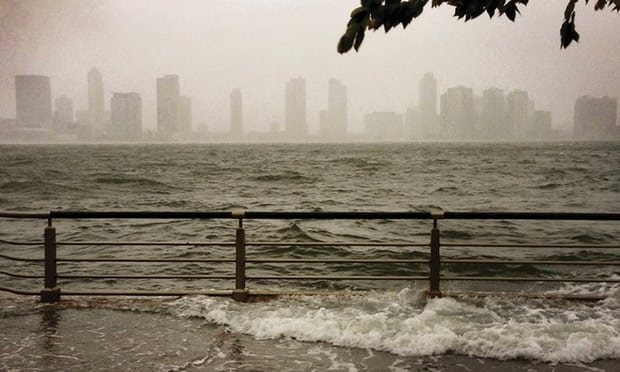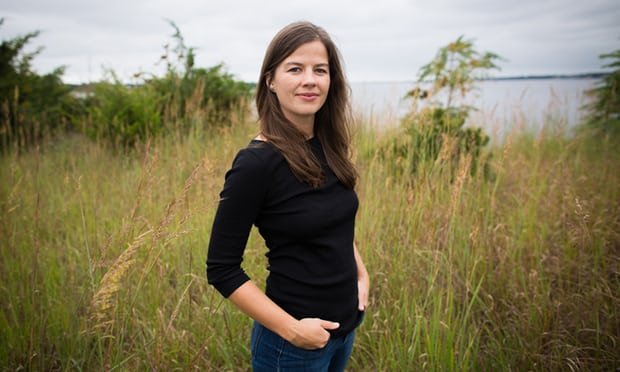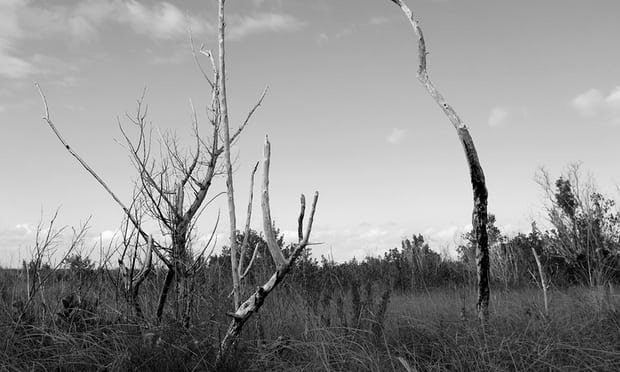Rising seas: 'Florida is about to be wiped off the map'

Sea level rises are not some distant threat; for many Americans they are very real. In an extract from her chilling new book, Rising, Elizabeth Rush details how the US coastline will be radically transformed in the coming years
Elizabeth Rush
Tue 26 Jun 2018 12.37 BST Last modified on Wed 27 Jun 2018 00.52 BST
In 1890, just over six thousand people lived in the damp lowlands of south Florida. Since then the wetlands that covered half the state have been largely drained, strip malls have replaced Seminole camps, and the population has increased a thousandfold. Over roughly the same amount of time the number of black college degree holders in the United States also increased a thousandfold, as did the speed at which we fly, the combined carbon emissions of the Middle East, and the entire population of Thailand.
About 60 of the region’s more than 6 million residents have gathered in the Cox Science Building at the University of Miami on a sunny Saturday morning in 2016 to hear Harold Wanless, or Hal, chair of the geology department, speak about sea level rise. “Only 7% of the heat being trapped by greenhouse gases is stored in the atmosphere,” Hal begins. “Do you know where the other 93% lives?”
Sea level rise: Miami and Atlantic City fight to stay above water
A teenager, wrists lined in aquamarine beaded bracelets, rubs sleep from her eyes. Returns her head to its resting position in her palm. The man seated behind me roots around in his briefcase for a breakfast bar. No one raises a hand.
“In the ocean,” Hal continues. “That heat is expanding the ocean, which is contributing to sea level rise, and it is also, more importantly, creating the setting for something we really don’t want to have happen: rapid melt of ice.”
A woman wearing a sequined teal top opens her Five Star notebook and starts writing things down. The guy behind her shovels spoonfuls of passionfruit–flavored Chobani yogurt into his tiny mouth. Hal’s three sons are perched in the next row back. One has a ponytail, one is in a suit, and the third crosses and uncrosses his gray street sneakers. The one with the ponytail brought a water bottle; the other two sip Starbucks. And behind the rows and rows of sparsely occupied seats, at the very back of the amphitheater, an older woman with a gold brocade bear on her top paces back and forth.
A real estate developer interrupts Hal to ask: “Is someone recording this?”
“Yes.” The cameraman coughs. “Besides,” Hal adds, “I say the same damn thing at least five times a week.” Hal, who is in his early seventies and has been studying sea level rise for over 40 years, pulls at his Burt Reynolds moustache, readjusts his taupe corduroy suit, and continues. On the screen above his head clips from a documentary on climate change show glacial tongues of ice the size of Manhattan tumbling into the sea. “The big story in Greenland and Antarctica is that the warming ocean is working its way in, deep under the ice sheets, causing the ice to collapse faster than anyone predicted, which in turn will cause sea levels to rise faster than anyone predicted.”
everglades
‘Dig into geologic history and you discover this: when sea levels have risen in the past, they have usually not done so gradually, but rather in rapid surges.’ Photograph: Milkweed Editions
According to Marco Rubio, the junior senator from Florida, rising sea levels are uncertain, their connection to human activity tenuous. And yet the Intergovernmental Panel on Climate Change expects roughly two feet of rise by century’s end. The United Nations predicts three feet. And the National Oceanic and Atmospheric Administration estimates an upper limit of six and a half feet.
Take the 6 million people who live in south Florida today and divide them into two groups: those who live less than six and a half feet above the current high tide line, and everybody else. The numbers slice nearly evenly. Heads or tails: call it in the air. If you live here, all you can do is hope that when you put down roots your choice was somehow prophetic.
But Hal says it doesn’t matter whether you live six feet above sea level or sixty-five, because he, like James Hansen, believes that all of these predictions are, to put it mildly, very, very low. “The rate of sea level rise is currently doubling every seven years, and if it were to continue in this manner, Ponzi scheme style, we would have 205 feet of sea level rise by 2095,” he says. “And while I don’t think we are going to get that much water by the end of the century, I do think we have to take seriously the possibility that we could have something like 15 feet by then.”
It’s a little after nine o’clock. Hal’s sons stop sipping their lattes and the oceanographic scientist behind me puts down his handful of M&M’s. If Hal Wanless is right, every single object I have seen over the past 72 hours – the periodic table of elements hanging above his left shoulder, the buffet currently loaded with refreshments, the smoothie stand at my seaside hotel, the beach umbrellas and oxygen bars, the Johnny Rockets and seashell shop, the lecture hall with its hundreds of mostly empty teal swivel chairs – will all be underwater in the not-so-distant future.
Elizabeth Rush.
Elizabeth Rush. Photograph: Stephanie Ewens
One of the few stories I remember from the Bible vividly depicts the natural and social world in crisis. It is the apocalyptic narrative par excellence – Noah’s flood. When I look it up again, however, I am surprised to find that it does not start with a rainstorm or an ark, but earlier, with unprecedented population growth and God’s scorn. It begins: “When human beings began to increase in number on the earth.” I read this line and think about the 6,000 inhabitants of south Florida turning into 6 million in 120 short years. “The LORD saw how great the wickedness of the human race had become.” I think about the exponential increase in M&M’s, Chobani yogurt cups and grande lattes consumed over that same span of time. The dizzying supply chains, cheap labor and indestructible plastic. “So God said to Noah, ‘I am going to put an end to all people, for the earth is filled with violence because of them.’” And then the rain began.
I do not believe in a vengeful God – if God exists at all – so I do not think of the flood as punishment for human sin. What interests me most is what happens to the story when I remove it from its religious framework: Noah’s flood is one of the most fully developed accounts of environmental change in ancient history. It tries to make sense of a cataclysmic earthbound event that happened long ago, before written language, before the domestication of horses, before the first Egyptian mummies and the rise of civilization in Crete. An event for which the teller clearly held humans responsible.
Coral reefs ‘will be overwhelmed by rising oceans’
Dig into geologic history and you discover this: when sea levels have risen in the past, they have usually not done so gradually, but rather in rapid surges, jumping as much as 50 feet over a short three centuries. Scientists call these events “meltwater pulses” because the near-biblical rise in the height of the ocean is directly correlated to the melting of ice and the process of deglaciation, the very events featured in the documentary footage Hal has got running on a screen above his head.
He shows us a clip of the largest glacial calving event ever recorded. It starts with a chunk of ice the size of Miami’s tallest building tumbling, head over tail, off the tip of the Greenland Ice Sheet. Then the Southeast Financial Center goes, displaying its cool blue underbelly. It is a coltish thing, smooth and oddly muscular. The ground between the two turns to arctic ice dust and the ocean roils up. Next, chunks of ice the size of the Marquis Residences crash away; then the Wells Fargo Center falls, and with it goes 900 Biscayne Bay. Suddenly everything between the Brickell neighborhood and Park West is gone.

The clip begins again and I watch in awe as a section of the Jakobshavn Glacier half the size of all Miami falls into the sea.
“Greenland is currently calving chunks of ice so massive they produce earthquakes up to six and seven on the Richter scale,” Hal says as the city of ice breaks apart. “There was not much noticeable ice melt before the nineties. But now it accelerates every year, exceeding all predictions. It will likely cause a pulse of meltwater into the oceans.”
Rising Book Jacket
Photograph: Milkweed Editions
In medicine, a pulse is something regular – a predictable throb of blood through veins, produced by a beating heart. It is so reliable, so steady, so definite that lack of a pulse is sometimes considered synonymous with death. A healthy adult will have a resting heart rate of 60 to 100 beats per minute, every day, until they don’t. But a meltwater pulse is the opposite. It is an anomaly. The exception to the 15,000-year rule.
From 1900 to 2000 the glacier on the screen retreated inward eight miles. From 2001 to 2010 it pulled back nine more; over a single decade the Jakobshavn glacier lost more ice than it had during the previous century. And then there is this film clip, recorded over 70 minutes, in which the glacier retreats a full mile across a calving face three miles wide. “This is why I believe we are witnessing the beginning of the largest meltwater pulse in modern human history,” Hal says.

As the ice sheets above Hal’s head fall away and the snacks on the buffet disappear, topography is transformed from a backwater physical science into the single most important factor determining the longevity of the Sunshine State. The man seated next to me leans over. “If what he says is even half true,” he whispers, “Florida is about to be wiped off the map.”